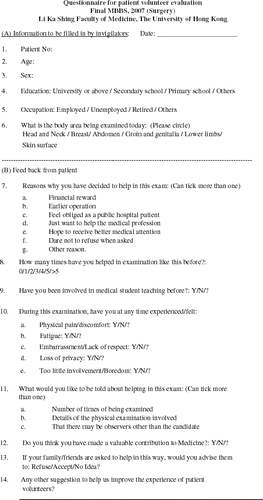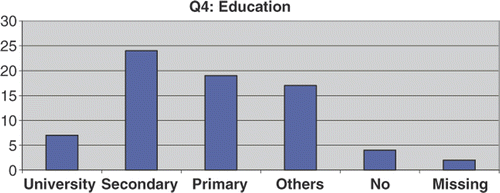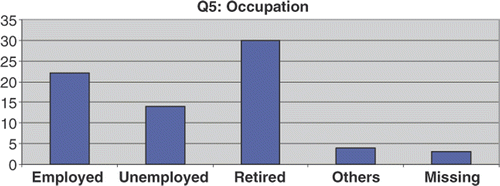Abstract
Aim: Real patients are generally recruited to participate in assessment of medical students all over the world in their clinical examinations. In the past, such voluntary patients were taken for granted. However, this is no longer true nowadays.
Method: A questionnaire survey was conducted on 72 patients who participated as volunteers in an undergraduate final MBBS clinical examination. Each patient underwent a total of three to four focused physical examinations, at the conclusion of which the survey was conducted.
Results: The majority of the subjects had little or no previous encounters with medical students. Most volunteers reported to have participated out of a willingness to help. Only a small number did so for financial rewards or more expeditious medical treatment. Positive experiences were reported by 82% of the volunteers and over 90% said they would encourage others to participate similarly. Fatigue is a common complaint which may be due to the long duration of the examination rather than the number of physical examinations performed. Volunteers expected to be better informed about the details of the examination including the numbers of times of physical examination, and the presence of observers.
Conclusion: Printed information given during recruitment, and briefing sessions conducted immediately prior to the examination are recommended to improve patients’ satisfaction
Introduction
Assessment is a crucial component in any teaching programme and curriculum. The so-called ‘bed-side’ clinical competency test is an important format in which medical students are assessed in a setting resembling real-life clinical encounters. Patient volunteers are commonly recruited to participate in these examinations and their willingness to do so has been taken for granted by many in the past. While most of these volunteers are indeed willing participants who find the experience agreeable, there are reports of dissatisfaction with the process (King et al. Citation1992). It is therefore important to address their experiences and perception, not only to protect and ensure their rights and well-being, but also to encourage their and others’ participation in the future. In the present study, we aimed to investigate patients’ attitudes and experiences with undergraduate clinical examination.
Objective
The principal aim is to study patient attitudes towards participating in the final MBBS examinations as voluntary patients in General Surgery. We also wanted to see the volunteers’ (patients) attitudes towards helping in the final MBBS examination.
Setting
A General Surgical Examination was conducted at a university-based teaching hospital.
Methods
This is a prospective questionnaire survey on patient volunteers who participated in the final MBBS examinations in General Surgery at a university-based hospital. The examination lasted 2 days during which 170 medical students were assessed. A total of 72 patient volunteers were recruited; 40 patients for the first day and 32 for the second day. At any one time, 16 volunteers were involved, distributed equally amongst four examination cubicles manned by invigilators. Each patient was subject to physical examination for a total of three to four times by student candidates under the supervision of examiners. Each volunteer received honorarium to cover their travelling expenses. Patients who were on waiting lists for elective operations (e.g., hernia repair) were able to receive the same treatment in the afternoon of the clinical examination. No hospital admission fee was charged.
At the end of the examination, the patients were given a questionnaire (set in both English and Chinese) to fill in anonymously and on a voluntary basis. The questionnaire was collected after 30 min (see the appendix) Briefly, the questionnaire aimed to study the motivations behind their participation and their experiences with taking part in the examination.
Results
There were 36 men (50%) and 36 (50%) women, with a mean age of 59.0 years (range: 28–78). For most patients, it was their first encounters with medical students. Only 17 (23.6%) of them were previously involved in medical teaching activities. Seven patients (10.7%) had participated in clinical examinations as volunteers previously. The majority (75%) received some degree of education, with 39% attaining secondary education or above. () Their employment status is listed in .
None of the patients reported that they had volunteered for financial reasons although three (4.2%) reported that it was part of their considerations. A wish to help the medical profession was reported to be the main reason to participate by most of the volunteers (73.3%). Also 47% reported that they ‘felt obliged to help as public hospital patients’. Around one-fifth of the patients reported that they participated in order to get an earlier operation or better treatment.
The majority of the patients (82.7%) did not report any experience of pain or discomfort during the whole examination process, while 34.7% patients reported feeling fatigue. Feelings of embarrassment or loss of privacy were reported by 8.3% and 12%, respectively. Twenty-eight per cent of patients reported that there was little involvement and were bored. Overall, 53 (73.6%) of volunteers reported the feeling of having made ‘a positive and valuable contribution to the medicine’. Ninety per cent of the subjects would advise their friends and relatives to participate as volunteers in the future.
The following observations were made based on the comments provided by the volunteers:
Around 49.3% would like to be told how many times they would be examined.
Around 38.7% of the patients would like to be given a briefing session prior to the examination, and to know more about the detailed arrangement.
Also 54.7% of them would like to know that there may be observers other than the candidates.
Discussion
Patients’ experiences and perceptions on participation in medical teaching activities have been widely reported from both hospital and primary care settings (King et al. Citation1992; Jones et al. Citation1996; Nair et al. Citation1997). But because clinical assessment exercises often take place outside normal clinical settings (e.g. in an examination hall), patient volunteers in examination may have acquired experiences different from being involved in teaching activities. Viewpoints from patients participating in clinical assessment have received relatively little attention, however. While their involvement is mostly voluntary, the underlying reasons for their participation are mostly not known.
The patients’ volunteers in the present study were mostly educated individuals who had little or no previous encounter with medical students. Our findings indicated that their experiences were generally very positive, as had been described in a previous study (Jones et al. Citation1996). But since patients were questioned only on a fixed set of negative experiences, other negative (or positive) experiences may have been over-looked. Up to one-third of our volunteers did report feeling fatigue, which, in retrospect, was more likely due to the duration of the examination (several hours) rather than the number of physical examinations conducted on each patient. It is therefore important for examination organizers not to under-estimate the degree of physical demand on these patients.
The majority of patients reported that they participated because they wanted to help or felt obliged to make contributions to medical education; only a minority admitted to having more personal motivations. It is therefore conceivable that many of our volunteers considered themselves ‘helpers’ or ‘contributors’ instead of just patients and would expect to be treated accordingly. While this should not affect the way volunteers are to be recruited or treated, it is important to address what could be very different expectations. Whether our reports reflected their true motivations cannot be ascertained although there is no reason why the questions were not answered truthfully.
Another finding was that our volunteers wished they were better informed about the arrangement of the examination, such as the total number of physical examinations to be performed. Moreover, more than half of them were concerned about the presence of observers other than the examiners and candidates. These ‘observers’ were mainly surgical trainees, non-candidate medical students and nurse helpers. This is in contrast with what had been reported previously that in a General Practice setting, patients generally did not mind student's presence during consultations. 3 Patients commonly have a perceived lack of information. In the present case, although the said information had been given during recruitment, they were not repeated on the day of the examination. The present study therefore supported the use of printed information and briefing session immediately prior to the start of examination in order to improve this patient's satisfaction. 5
Conclusion
The present study demonstrated that the majority of patient volunteers involved in clinical assessment had positive experiences. The ‘willingness to contribute’ was reported by many to be the main reason to participate. Volunteers generally expected to be better informed about he details of the arrangement. The use of printed information and briefing session immediately prior to the examination may help to improve their experiences.
Declaration of interest: The authors report no conflicts of interest. The authors alone are responsible for the content and writing of the article.
Notes on contributors
All the authors were involved in the conception and design of the questionnaire. Acquisition of the data was done at the time of the final MBBS examination. All the authors were involved in the examination process and were present at the time of the said survey. Analysis and interpretation of the data was done by the principal author but all the authors were involved in drafting, revising and re-revising the content critically The final version of the article was approved by all the authors.
References
- Jones S, Oswald N, Date J, Hinds D. Attitudes of patients to medical students participation: General practice consultations on the Cambridge Community-based Clinical Course. Med Educ 1996; 30: 14–17
- King D, Benbow S, Elizabeth J, lye M. Attitude of elderly patients to medical students. Med Educ 1992; 26: 360–363
- Nair BR, Coughlan JL, Hensley MJ. Student and patient perspectives on bedside teaching. Med Educ 1997; 31: 341–346
- Welfare MR, Price CIM, Han SW, Barton JR. Experience of voluntary patients during undergraduate examinations: Printed information can lead to greater satisfaction. Med Educ 1999; 33: 165–169
- Welfare MR, Scott J, Williams H, Dellipiani AW. The MRCP (UK) examination from the patient's point of view. J R Coll Physicians (London) 1994; 28: 527–529
Appendix


